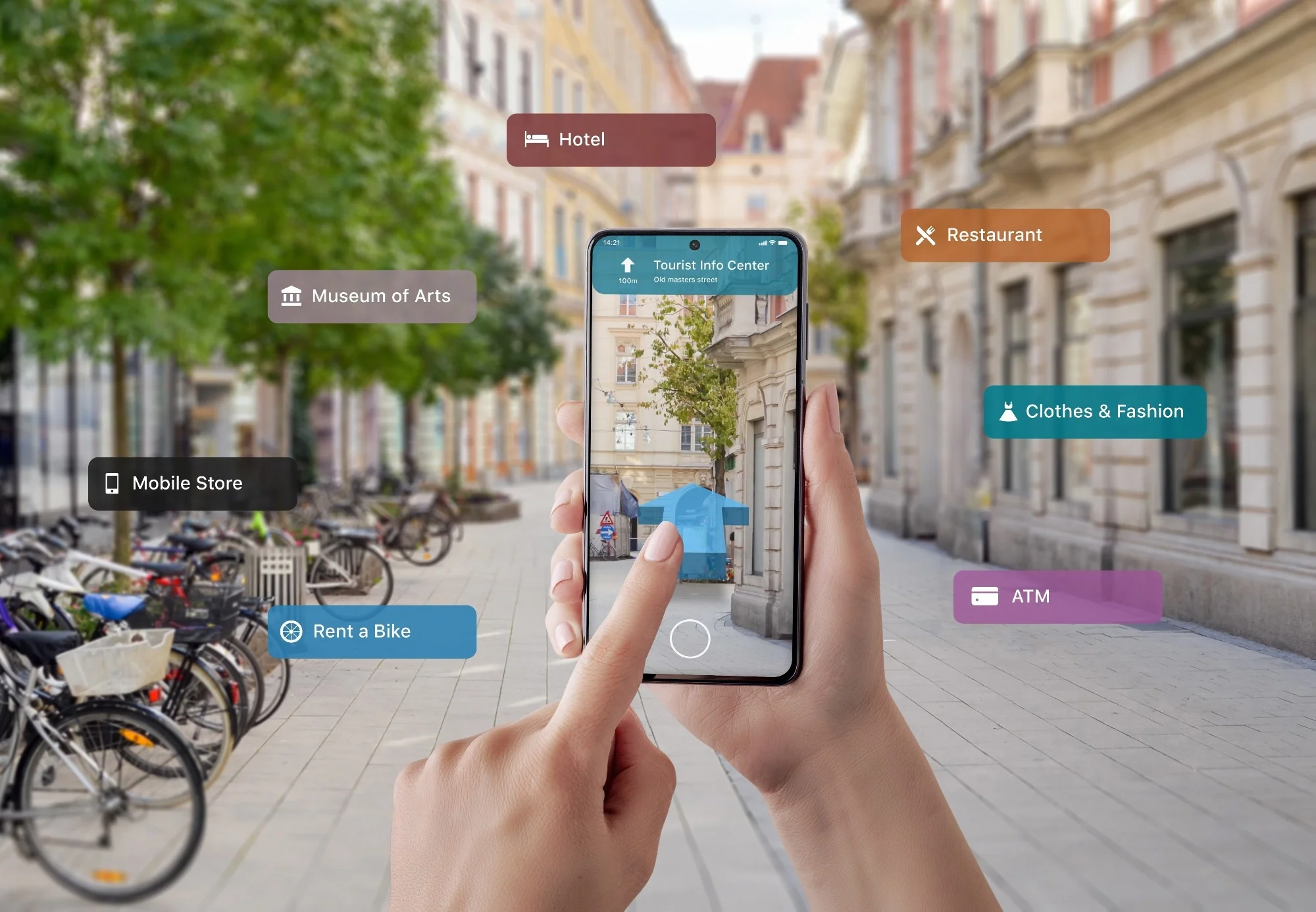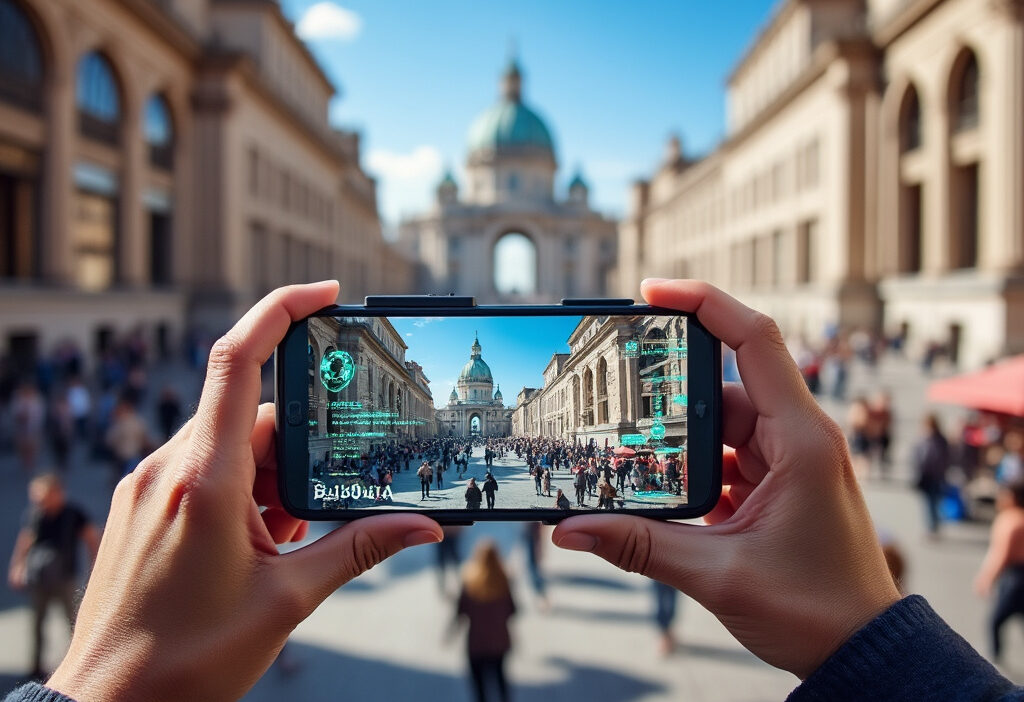AR Adventures: Enhancing Your Travel Experience with Augmented Reality
Augmented Reality (AR) is reshaping the travel experience, making it more immersive, personalized, and interactive. By 2025, AR technology has evolved to enhance every stage of travel, from planning to exploration, by overlaying digital information onto the real world. This article delves into the transformative impact of AR on tourism, offering a glimpse into a future where travel is augmented by cutting-edge technology.
The Dawn of AR in Travel
Augmented Reality (AR) has evolved from a futuristic concept to a cornerstone of modern travel, reshaping how we explore the world. In its infancy, AR was limited to simple overlays—think basic navigation arrows or rudimentary historical reconstructions. Fast forward to 2025, and AR has become a seamless, immersive tool, blending the physical and digital worlds to elevate every aspect of tourism.
Key milestones mark this transformation. The 2010s saw the rise of AR apps like Layar and Google Lens, offering travelers real-time translations and contextual information about landmarks. By the mid-2020s, advancements in wearable tech and spatial computing enabled AR glasses to project interactive guides, 3D historical reenactments, and even personalized tour recommendations. The integration of AI-driven contextual awareness allowed AR systems to adapt to user preferences, making every experience uniquely tailored.
What began as a novelty—snapping AR-filtered photos or playing location-based games like Pokémon GO—has matured into a necessity. Travelers now rely on AR for:
- Enhanced sightseeing: Overlaying dynamic content onto landmarks, such as animated historical events or architectural evolution timelines.
- Real-time navigation: AR waypoints projected onto streets, reducing reliance on clunky 2D maps.
- Crowd-sourced insights: Live AR annotations from fellow travelers, highlighting hidden gems or hazards.
The shift from gimmick to essential tool reflects broader tech trends: faster 5G networks, improved computer vision, and the ubiquity of AR-ready devices. As we move into the era of hyper-personalized travel, AR’s role is no longer optional—it’s the lens through which we see and interact with the world.
Planning Your Journey with AR
Planning your journey has never been more immersive, thanks to the integration of augmented reality (AR) into travel platforms. In 2025, travelers no longer rely solely on static images or vague descriptions when booking accommodations or choosing destinations. Instead, they can virtually step inside hotels, stroll through neighborhoods, and even preview attractions—all from their smartphones or AR glasses.
Leading the charge are AR-enhanced booking platforms, which allow users to scan QR codes or use geolocation triggers to unlock 3D models of hotels and rental properties. Imagine pointing your device at a brochure or website and instantly seeing a life-sized, interactive rendering of your potential room. Users can inspect amenities, check views from balconies, and even simulate different lighting conditions to gauge the ambiance. This level of detail eliminates guesswork, reducing post-booking disappointments and fostering confidence in travel decisions.
Beyond accommodations, AR aids in itinerary planning. Travelers can overlay digital guides onto real-world locations, previewing landmarks, restaurants, and events before arrival. For instance, pointing a phone at a city map might reveal pop-up reviews, crowd predictions, or time-sensitive deals. Some platforms even offer AI-driven recommendations, suggesting personalized activities based on past preferences or real-time trends.
The impact is profound:
- Virtual walk-throughs let travelers “test” destinations before committing, saving time and money.
- Dynamic previews adjust to weather or time of day, offering realistic expectations.
- Collaborative planning enables groups to explore options together in shared AR spaces, even remotely.
As AR continues to evolve, the line between digital and physical travel planning blurs, setting the stage for even more intuitive navigation tools—a seamless bridge to the next chapter’s focus on real-time wayfinding.
Navigating Destinations with Ease
Navigating unfamiliar destinations has always been a challenge for travelers, but augmented reality (AR) is changing the game by turning confusion into seamless exploration. In 2025, AR-powered navigation tools are no longer a novelty but a necessity, integrated into mobile devices and smart glasses to provide real-time, intuitive guidance. Unlike traditional maps, AR overlays directional arrows, points of interest, and even distance markers directly onto the user’s field of view, blending digital cues with the physical environment.
One of the most significant advancements is the personalization of AR navigation. Travelers can now receive tailored recommendations based on their preferences—whether it’s the quickest route to a landmark, a scenic detour, or hidden gems off the beaten path. For instance, smart glasses can highlight nearby cafes with high ratings or notify users of limited-time events as they walk. This dynamic interaction eliminates the need to constantly check a phone, allowing for a more immersive and hands-free experience.
AR also excels in indoor navigation, a traditionally tricky area for GPS. Airports, museums, and shopping centers leverage AR wayfinding to guide visitors with floor plans and step-by-step directions. Imagine arriving at a sprawling train station and seeing virtual signs floating above platforms, or getting real-time updates on gate changes—all without glancing at a screen.
The technology’s real-time adaptability is another game-changer. AR navigation adjusts instantly to disruptions like construction or crowded streets, offering alternative routes. By merging practicality with interactivity, AR doesn’t just help travelers reach their destinations—it transforms the journey itself into part of the adventure, setting the stage for the next chapter’s dive into immersive sightseeing.
Immersive Sightseeing Experiences
Augmented Reality is revolutionizing the way travelers engage with historical sites, museums, and cultural landmarks, turning passive sightseeing into an interactive journey through time. By overlaying digital reconstructions, animations, and multimedia content onto physical locations, AR breathes life into ancient ruins, forgotten stories, and artistic masterpieces. Imagine standing in front of the Colosseum in Rome and witnessing gladiatorial combat unfold before your eyes, or exploring the ruins of Pompeii as they were before the eruption of Mount Vesuvius—all through the lens of your AR-enabled device.
Museums are leveraging AR to create layered experiences that deepen understanding. For example, the British Museum uses AR to reconstruct artifacts in their original context, allowing visitors to see how a broken statue once looked or how an ancient tool was used. Similarly, the Louvre offers AR-guided tours where paintings come alive, revealing hidden details or the artist’s creative process. These applications don’t just entertain—they educate, offering historical context that static plaques or audio guides cannot match.
Cultural institutions are also using AR to make heritage more accessible. At Angkor Wat, AR headsets project temple reconstructions over the weathered stones, helping visitors visualize the site’s former grandeur. In cities like Kyoto, AR apps overlay traditional festivals or geisha performances onto modern streets, bridging past and present. These immersive experiences foster a deeper connection to the places travelers visit, enriching their appreciation of global heritage.
By blending education with engagement, AR transforms sightseeing from a passive activity into an interactive exploration. As travelers move beyond navigation aids—discussed in the previous chapter—they enter a world where history is no longer confined to textbooks but unfolds dynamically around them. This sets the stage for the next chapter, which explores how AR preserves and promotes local cultures, ensuring their stories endure for future generations.
The Impact of AR on Local Cultures and Heritage
Augmented reality is not just reshaping how travelers explore destinations—it’s also playing a pivotal role in preserving and revitalizing local cultures and heritage. By overlaying digital reconstructions and interactive narratives onto physical sites, AR bridges the gap between the past and present, allowing visitors to engage with history in ways that were previously unimaginable. Unlike traditional sightseeing, which often relies on static displays or guidebooks, AR fosters a deeper connection by immersing users in culturally rich, context-driven experiences.
One standout example is the TimeLooper app, which has been used at historical sites like Pompeii and the Colosseum. By superimposing animated scenes of ancient life onto ruins, travelers witness bustling marketplaces or gladiatorial combat as if stepping into a time machine. Similarly, the Smithsonian’s AR Museum initiative brings indigenous artifacts to life, sharing oral histories and traditional craftsmanship techniques through 3D holograms. These projects don’t just entertain—they educate, ensuring that cultural knowledge is passed down accurately and engagingly.
AR also empowers local communities to reclaim and share their heritage on their own terms. In New Zealand, the Māori AR Experience lets visitors interact with digital taonga</i (treasures) while hearing stories narrated by tribal elders. This not only boosts tourism but also reinforces cultural pride and authenticity. Meanwhile, in Cambodia, the Angkor Wat AR Project reconstructs temple murals eroded by time, offering insights into Khmer mythology without physical restoration risks.
By blending technology with tradition, AR ensures that heritage isn’t just preserved—it’s celebrated dynamically. As travelers gain a richer understanding of local cultures, they become advocates for their conservation, creating a sustainable cycle of appreciation and protection. This sets the stage for the next evolution of AR in travel: enhancing hospitality services to further personalize and elevate the journey.
AR-Enhanced Accommodations and Services
The hospitality industry is embracing augmented reality (AR) to redefine guest experiences, blending digital innovation with personalized service. Hotels and resorts now leverage AR to streamline check-ins, offering guests the ability to scan QR codes for instant room access or virtual concierge assistance. No longer confined to static brochures, travelers can take virtual tours of properties before booking, exploring room layouts, amenities, and even views through immersive 3D overlays.
Room service has also evolved with AR-enhanced menus. By pointing their smartphones at in-room dining options, guests can see holographic previews of dishes, complete with nutritional information and ingredient origins—bridging the gap between convenience and culinary transparency. Some luxury hotels integrate AR mirrors in bathrooms, allowing guests to check weather forecasts, local attractions, or even virtually try on outfits before stepping out.
Beyond convenience, AR personalizes stays. Facial recognition paired with AR profiles enables staff to greet guests by name and tailor recommendations based on past preferences. For families, interactive AR scavenger hunts turn lobbies into playful adventures, while business travelers benefit from AR meeting room setups that visualize seating arrangements and tech setups in real time.
Looking ahead, the potential is vast. Imagine AR-powered language translation in real time for international guests or AI-driven AR assistants that learn guest habits to adjust room lighting and temperature autonomously. As AR becomes more sophisticated, it won’t just enhance hospitality—it will redefine what it means to feel at home while traveling. This seamless integration of digital and physical experiences sets the stage for the next evolution in travel: self-guided AR tours, where exploration is as intuitive as it is immersive.
Self-Guided Tours and the Future of Travel
The rise of self-guided tours powered by augmented reality (AR) is redefining how travelers explore destinations in 2025. Unlike traditional guided tours, which follow rigid schedules and routes, AR-enabled tours offer unparalleled flexibility, allowing users to discover landmarks, museums, and cultural sites at their own pace. By simply pointing their smartphone or AR glasses at a point of interest, travelers unlock layers of interactive content—historical reenactments, 3D reconstructions, or narrated stories—tailored to their preferences.
One of the most transformative aspects of AR self-guided tours is the personalization they provide. Advanced algorithms analyze user behavior, adjusting recommendations in real-time. For instance, a history enthusiast might receive detailed accounts of ancient battles, while an art lover gets deep dives into brushstroke techniques. This level of customization surpasses what traditional guides can offer, making exploration more engaging and relevant.
The autonomy of AR tours also extends to accessibility. Language barriers dissolve as AR overlays provide instant translations of signs or spoken guides in multiple languages. Additionally, features like wayfinding arrows and crowd-avoidance routing enhance navigation in unfamiliar cities, reducing reliance on physical maps or tour operators.
As AR self-guided tours gain traction, their impact on the traditional guided tour industry is undeniable. While human-led tours still hold value for social interaction and expert insights, the convenience and adaptability of AR are shifting consumer expectations. Looking ahead, hybrid models—where AR supplements live guides—may emerge as the dominant format, blending the best of both worlds. This evolution aligns with broader trends in tech-driven tourism, setting the stage for deeper innovations discussed in the next chapter on market growth and AI integration.
Market Growth and Technological Innovations
The augmented reality (AR) tourism market is experiencing explosive growth, driven by advancements in hardware, software, and AI integration. Industry analysts project the global AR in tourism market to reach $4.2 billion by 2025, with a compound annual growth rate (CAGR) of 28.3% from 2021. This surge is fueled by travelers’ increasing demand for immersive, interactive experiences that bridge the physical and digital worlds.
Key innovations accelerating this growth include AI-powered AR assistants, which leverage machine learning to deliver hyper-personalized recommendations in real-time. These assistants analyze user behavior, preferences, and even facial expressions to tailor content dynamically—whether suggesting a hidden café or overlaying historical context on a landmark. Another breakthrough is AR cloud technology, enabling persistent digital layers tied to physical locations, allowing multiple users to interact with the same AR content simultaneously.
Emerging trends highlight the rise of wearable AR glasses, with companies like Apple and Meta pushing consumer adoption. By 2025, over 30% of travelers are expected to use AR wearables for navigation, translation, and contextual information. Additionally, 5G networks are eliminating latency issues, making AR experiences smoother and more responsive.
The integration of blockchain is also gaining traction, ensuring secure, tamper-proof AR content—critical for preserving cultural heritage sites and preventing misinformation. With these advancements, AR is no longer a novelty but a fundamental tool reshaping how travelers engage with destinations. As the technology matures, its role in tourism will expand beyond self-guided tours, unlocking new revenue streams for businesses and deeper engagement for users.
Challenges and Opportunities in AR Adoption
The rapid growth of AR in tourism, as highlighted in the previous chapter, comes with its own set of challenges. One major hurdle is technological limitations, such as device dependency and inconsistent connectivity in remote destinations. While smartphones are widely used for AR applications, the experience is often constrained by battery life, processing power, and screen size. Standalone AR glasses promise a more immersive experience but remain expensive and lack mass adoption. Additionally, privacy concerns arise as AR apps collect location data, preferences, and even biometric information, raising questions about data security and user consent.
Another barrier is user adoption. Many travelers, particularly older demographics, may find AR interfaces unintuitive or overwhelming. The learning curve for new technology can deter potential users, limiting the reach of AR-enhanced experiences. Furthermore, content localization remains a challenge—creating culturally and linguistically relevant AR experiences for diverse global audiences requires significant investment.
Despite these challenges, AR presents immense opportunities to revolutionize travel. By leveraging AI-driven personalization, AR can deliver tailored recommendations, interactive guides, and real-time translations, making travel more accessible and engaging. For instance, AR overlays can provide historical context at heritage sites or highlight hidden gems based on a traveler’s interests. The technology also enables gamification, turning sightseeing into interactive adventures through scavenger hunts or virtual rewards.
Moreover, AR can bridge the gap between physical and digital experiences, offering hybrid events or virtual previews of destinations before booking. As the industry addresses technological and adoption barriers, AR has the potential to create more dynamic, inclusive, and memorable travel experiences—laying the foundation for the innovations discussed in the next chapter.
Looking Ahead: The Future of AR in Travel
Looking ahead, the future of AR in travel promises to transcend current applications, evolving into a seamless, hyper-personalized layer of reality that enhances every aspect of the journey. By 2030, AR could integrate with spatial computing, enabling travelers to interact with digital overlays as naturally as physical objects. Imagine AI-driven AR guides that don’t just narrate history but adapt storytelling in real-time based on your interests, mood, or even biometric feedback—like elevating a tour’s drama if your heart rate suggests excitement.
Advancements in wearable technology will likely replace smartphones as the primary AR interface. Lightweight AR glasses with holographic displays could project immersive 3D reconstructions of ancient ruins or vanished landmarks directly into your field of vision, blending past and present effortlessly. Meanwhile, haptic feedback might simulate the texture of historical artifacts or the breeze of a virtual savannah during a wildlife tour, deepening sensory engagement.
Beyond sightseeing, AR could revolutionize logistics. Dynamic translation overlays might evolve to interpret local dialects and slang in real-time, while AR wayfinding could integrate with smart cities to highlight not just routes but crowd density, air quality, or even personalized dining recommendations based on dietary preferences.
The most transformative leap, however, could be social AR, where travelers share augmented experiences across distances. Friends separated by continents might virtually explore a museum together, annotating exhibits with shared notes or holographic doodles. As 5G/6G networks and edge computing reduce latency, these interactions will feel instantaneous, fostering a new era of collaborative travel—one where the line between physical and digital exploration dissolves entirely.

Conclusions
Augmented Reality is transforming travel and tourism into experiences that are more engaging, informative, and personalized than ever before. By intertwining digital information with the physical world, AR enables travelers to explore destinations in unprecedented ways. As technology continues to evolve, the potential for AR in travel promises even more innovative and immersive adventures, making each journey unforgettable.



